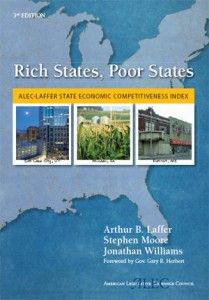Calif. Economy 47th Worst of States
By JOHN SEILER
California’s stagnating economy suffered more bad news by ranking 47th of the 50 states for economic outlook. The ranking comes from the new, fourth edition of “Rich States, Poor States: The ALEC-Laffer State Economic Competitiveness Index.” It combines 15 economic rankings, such as top marginal personal income tax rate and average workers’ compensation costs.
I received an advanced copy of the rankings, and will discuss them here. It will be released tomorrow, June 22, by the American Legislative Exchange Council, a nonpartisan group of state legislators. I’ll put up a link to it then. (Update: Here’s the link.)
In addition to ranking 47th in economic outlook, California ranked an almost-as-dismal 46th in economic performance for the previous decade, 2000-2009. It really was a “lost decade” for the state’s economy under the fumbling governorships of the recalled Gray Davis and his satyric replacement, Arnold Schwarzenegger.
The only states ranking worse on the economic outlook were New York, rock-bottom 50th, followed by Vermont and Maine. Along with California, all are high-tax, high-regulation, jobs-killing states. The three other states have bad weather.
The rankings put California’s income tax at fourth worst, assuming the top rate remains at 10.3 percent and Gov. Jerry Brown’s call for increasing that and other taxes are not heeded.
But California is rock-bottom worst in income tax progressivity. Our second highest rate, 9.3 percent, kicks in at around $50,000 of income, meaning the middle-class really gets gouged. It’s a high price to pay for the sunshine.
Hope for California
I asked if the state tax hikes are likely to go through. “I don’t think so,” the rankings’ co-author Arthur Laffer replied. “The Legislature didn’t put it on the ballot. And Jerry Brown just vetoed the unbalanced budget. There’s a lot of hope for the state.”
Laffer heads Laffer Associates in Tennessee, which he moved there a few years ago from San Diego to take advantage of the Volunteer State’s zero percent state income tax rate. Laffer helped craft President Reagan’s federal tax cuts in 1981 and 1986, which formed the foundation of 30 years of national economic growth.
And last week it was announced that Laffer would be working on the new California Recovery Project of the Pacific Research Institute, CalWatchDog.com’s parent think tank. Laffer already has produced an outline for a book he’s working on about how to get California’s economy moving again. The outline is a good overview of California’s political and economic past, and potential future recovery.
He also told me that he’s optimistic about Jerry Brown’s governorship, despite the governor’s plea for tax increases. “I’ve been associated with Jerry Brown for years.” He said that, during Brown’s first governorship in the 1970s and early 1980s, he worked with Brown to implement the Proposition 13 tax limitation, get voter approval for the Gann Limit on spending and repeal the state inheritance tax (the “death tax”).
Always enthusiastic, Laffer said, “If there’s one person who can transform California, it’s Jerry Brown. When he ran for president in 1992, he came out for a flat tax,” which was designed by Laffer. “It’s very exciting.”
The ongoing budget crisis, Laffer said, is essential to reach real reform. “You need sturm und drang to get revolutionary change,” he said. “California is a great place to live — except for the policies.”
Golden State Positives
On the positive side, the ALEC-Laffer rankings found some luster left on the Golden State. In addition to the great weather and the lack of a death tax, California ranks fourth best on tax limitations, thanks to Prop. 13 and other caps on taxing.
The state ranks seventh-best for public employees being 5 percent of the population. And…that’s about it on the positive side.
Other negatives include: 46th ranking for recently legislated tax changes (Schwarzenegger’s 2009 tax increases, which should expire on July 1), debt service as a share of tax revenue (at 8.5 percent, ranks 31st), 29th for sales tax burden and 46th for “tort litigation treatment and judicial impartiality” — even our courts are a mess.
Despite Prop. 13’s limits on property tax increases, which tax-increasers always are trying to repeal, California ranks only 31st on property tax burden. The problem there is that real estate here costs so much, even a low percentage tax brings in high revenues.
“Taxes matter a whole lot on economic growth,” co-author Jonathan Williams explained; he’s the director of ALEC’s Tax and Fiscal Policy Task Force. “The 2010 U.S. Census showed that people vote against income taxes and taxes on capital by leaving high-tax states.”
He pointed out how Texas and other low-tax states have benefited in the past decade by seeing an influx of businesses, jobs and workers. While high-tax states such as New York have seen an exodus.
California’s population grew the past decade — but, for the first time in its history, only at the national average. And its growth entirely was due to immigration from foreign countries.
The study concludes:
Over the past decade, the 10 biggest population gainers had an average state and local tax burden of $3,098. The average for the 10 states with the lowest population gain was $3,735—more than 20 percent greater. The average top personal income tax rate in the 10 fastest growing states was just more than 4 percent versus more than 7 percent in the 10 slowest growing states. Clearly, states with the steepest tax rates, poor labor policy, excessive levels of government spending and hiring, overregulation of business, and tort laws that encourage frivolous lawsuits end up chasing jobs, businesses, and families to other states. In contrast, low tax states were magnets for new residents.
In the years 2000-09, California also saw a net of 1.5 million residents leave the state for greener pastures in other states. Only New York saw more residents leave. These commonly were people with skills to earn middle-class incomes — and pay middle-class taxes.
Texas, Here They Come
During the economic recovery of the past two years, four out of 10 new jobs were created in just one state, Texas, co-author Stephen Moore pointed out; he’s a member of the Wall Street Journal editorial board. Yet Texas has just 8 percent of the U.S. population — and bad weather. So, it’s creating jobs at a rate five times the national average.
The major reasons, Moore explained, are that Texas has no state income tax and is a “right to work” state — meaning workers aren’t forced to join unions.
Pension Tsunami
The rankings also warned that, as bad as current state budget deficits are,
these budget gaps are overshadowed in size and scope by unfunded liabilities in state pension and health care systems for public employees, which are trillions of dollars in the red. These are unsustainable cost drivers that threaten the financial solvency of the states. Without fundamental pension reform, expect the news stories discussing the possibility of state bankruptcy to continue.
The ALEC survey cited three other studies on the scope of state pension liabilities. For California, a PEW Center for the States study found the liability at “only” $59 billion. But an American Enterprise Institute study calculated it to be $398 billion. And a Novy-Marx and Raugh study calculated it at $370 billion.
The latter two numbers are similar to the more than $500 billion found in a Stanford University study last year. The ALEC-Laffer survey concluded that the PEW numbers were underestimating the true magnitude of state pension liabilities, and that the higher numbers are more accurate.
However you look at it, California’s unfunded pension liabilities are immense.
On a positive note, the ALEC-Laffer survey found that pension reform is advancing. In the lead is Utah, which also topped the survey as the state with the best economic outlook. It quoted state Senator Dan Liljenquist of Utah, an ALEC member, who testified before the U.S. Congress:
Utah closed its defined-benefit pension plans to new enrollees, creating a new retirement system for new employees hired after July 1, 2011. Under Utah’s new retirement system, public employees will receive a defined employer contribution towards retirement. New public employees will be able to choose between (1) a 401(k)style program, or (2) a hybrid pension program (where they may pool market risk with other employees). Regardless of the program employees choose, Utah will only contribute at a set amount towards retirement. Utah’s recent pension reforms will, over time, reduce and eliminate Utah’s pension related bankruptcy risk. This is a big win for Utah taxpayers.
Reforms Needed
Ultimately, California and other states will need to adopt Utah-style pension reforms to avoid pension payments gobbling up 100 percent of a state or local government’s budget.
The ALEC-Laffer rankings also serve as a blueprint for reforms in high-tax, high-regulations states such as California. The only way the state can back on track to economic growth is to reduce the immense burden government places on taxpayers.
Related Articles
CA fiscal health ranks 44th in country
In fiscal year 2013-14, California saw a slight uptick in the condition of its fiscal health, based on fiscal solvency
Dems damn dams
JUNE 16, 2010 By KATY GRIMES With a win for PG&E but a loss for hydroelectric power plants in the
How California is killing us
JUNE 24, 2010 By ANTHONY PIGNATARO The danger is apparently everywhere, all around us. No need to worry anymore about




